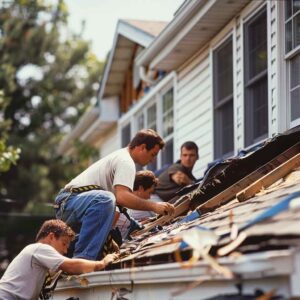When selecting a fire-resistant roofing material, it’s crucial to weigh factors like cost-effectiveness, environmental impact, and material longevity. This decision not only safeguards our building and its occupants but also mitigates the spread of fires and ensures compliance with safety regulations. Engaging with roofing professionals can provide invaluable insights into the best options available, considering installation requirements, budget constraints, and sustainability objectives. By prioritizing sustainable choices, we protect our property and contribute to environmental conservation efforts.
Regular maintenance and inspections are vital for effective prevention of fire damage. Prompt repairs guarantee longevity. Investing in high-quality, long-lasting, fire-resistant roofing saves costs significantly. These essentials guide us towards choosing a secure and sustainable roofing option.
Importance of Fire-Resistant Roofing
Selecting fire-resistant roofing material is crucial for safeguarding buildings and occupants from the destructive effects of fires. When it comes to fire safety, choosing a suitable roofing material can significantly reduce the spread and impact of fires within a building. Building regulations often mandate fire-resistant roofing to enhance overall safety measures.
These regulations aim to minimize the risk of fire-related incidents and uphold that buildings meet specific safety standards. By adhering to these regulations and opting for fire-resistant roofing materials, property owners can create a safer environment for occupants and reduce the potential for extensive damage in the event of a fire. Prioritizing fire-resistant roofing aligns to enhance building safety and protect lives and property.
Factors to Consider
Various factors influence the overall effectiveness of safeguarding buildings and occupants from fire hazards when considering fire-resistant roofing material. Weighing the available cost-effective options is vital in making this decision. Opting for fire-resistant and economical materials can provide a practical solution for many homeowners and businesses.
Moreover, considering the environmental impact of the roofing material is essential. Choose materials that are not only fire-resistant but also eco-friendly, reducing the overall carbon footprint of the building. By carefully evaluating these factors, one can select a fire-resistant roofing material that meets safety requirements and aligns with budget constraints and sustainability goals.
Types of Fire-Resistant Materials
Various fire-resistant materials offer distinct advantages in safeguarding buildings and occupants from fire hazards. When considering fire-resistant roofing materials, the installation process and cost comparison are essential to analyze. Some materials may require specialized installation techniques, impacting overall costs. Moreover, it is vital to evaluate the chosen material’s environmental impact and energy efficiency. Opting for sustainable and energy-efficient roofing materials contributes to environmental conservation and can lead to long-term cost savings.
By carefully evaluating these aspects, property owners can select a fire-resistant roofing material that aligns with their safety requirements, budget constraints, and sustainability goals.
Maintenance and Longevity
Considering the installation process and cost considerations of fire-resistant roofing materials, it is essential to evaluate the maintenance requirements and longevity of the selected material to ensure sustained protection and durability. Regular inspection guarantees the roofing material’s effectiveness in preventing fire damage. The inspection frequency should be outlined by the manufacturer and adhered to strictly.
Prompt repair of any damage or wear is necessary to maintain the material’s fire-resistant properties. When assessing the longevity of the roofing material, it is important to weigh the initial cost against its long-term durability. Investing in high-quality, long-lasting, fire-resistant roofing material may require a higher upfront cost. Still, it can result in significant cost savings over time due to reduced maintenance and replacement expenses.
Other Roofing Tips:





